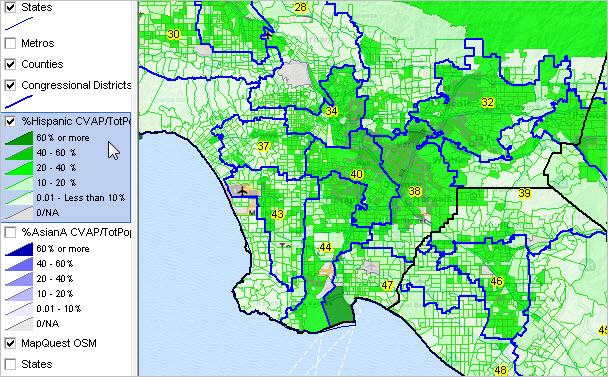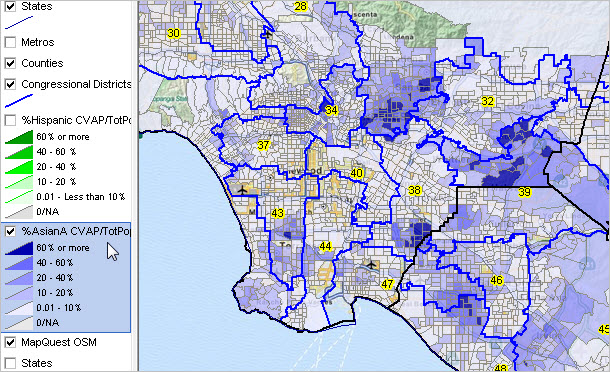

|
|
-- examining voting age population by neighborhood in relation to voting districts & Congressional Districts October 2015. Examining patterns of the citizen voting age population ... the Voting Rights Act prohibits development of voting districts that discriminate against potential voters on the basis of race and/or language minority status. To examine how voting districts comply with the Voting Rights Act requires data on the citizen voting age population (CVAP) by race/origin for small geographic areas. The ACS 2013 5-year CVAP special tabulation provides these estimates for census tracts and block groups. Related CVAP Sections • Block Groups; ACS 2010-14 special tabulation • Census Tracts; ACS 2009-13 special tabulation • Census Tracts; ACS 2009-13 special tabulation - Hispanic focus The CVAP data can be used to develop insights into alternative interpretations of "one person one vote." The Supreme Court on May 26, 2015, agreed to hear a case that will answer a long-contested question about a principle of the American political system -- the meaning of "one person one vote." The court has never resolved whether that means that voting districts should have the same number of people, or the same number of eligible voters. The difference matters in places with large numbers of people who cannot vote legally, including immigrants who are here legally but are not citizens; unauthorized immigrants; children; and prisoners. The CVAP estimates provide only one part of the required data. The voting district boundaries are also needed to be used in combination with the CVAP estimates. Using GIS tools, the CVAP estimates can be used in mapping applications, such as those reviewed in this section, in combination with voting district boundaries to reveal potential non-compliance in the structure of voting districts. Use the interactive table in this section to view/rank/compare/query national scope citizen and CVAP estimates by race/ethnicity by census tract. See more about these data.
ProximityOne develops custom maps and provides related analyses of the Citizen Voting Age Population
by census tract or block group
optionally in context of Congressional Districts, state legislative districts, voting districts,
census block clusters and other geography.
Contact us (888.364.7656) for further information.
Patterns of CVAP Hispanic Population by Neighborhood The map presented below shows patterns of the Hispanic citizen voting age population as a percent of total population by census tract in the Los Angeles area. Percentage intervals by green color pattern (see in legend at left of map). Congressional Districts are shown with dark blue boundaries and labeled with congressional district codes. It is easy to see where concentrations of percent Hispanic citizen voting age population are located and how the distribution relates to congressional districts.  Click graphic for larger view; view developed with CV XE GIS. Map view developed using CVAP2013 GIS Project. Patterns of CVAP Asian Alone Population by Neighborhood The map presented below shows patterns of the Asian alone citizen voting age population as a percent of total population by census tract in the Los Angeles area. Percentage intervals are shown by blue color patterns (see in legend at left of map). Congressional Districts are shown with dark blue boundaries and labeled with congressional district codes. It is easy to see where concentrations of percent Asian alone citizen voting age population are located and how the distribution relates to congressional districts.  Click graphic for larger view; view developed with CV XE GIS. Map view developed using CVAP2013 GIS Project. Additional Views • Harris County, TX; %CVAP Hispanic Population by Neighborhood: note patterns of CD 29 • Harris County, TX; CVAP population in a tract related to voting districts/VTD and blocks - zoom-in to tract above pointer in above view. - shows relationship between 1) tract; CVAP populationprofile, 2) VTD (red, tract split by 2 VTDs), and 3) census blocks - post 2010 VTDs (post redistricting); not available in TIGER/Line files. Citizen Voting Age Population by Census Tract: ACS 2009-13 Interactive Table See related Ranking Tables Main Page Usage: click column header to sort; click again to sort other direction. Column Headers; Subject Matter Items All special tabulation estimates are based on survey respondent data collected 2009-2013 and are centric to mid-201.
geoid -- Census 2010 census tract code SS-CCC-TTTTTT
state -- state postal abbreviation Citizen Population citizens - total population citizens - Not Hispanic or Latino (NH) citizens - American Indian or Alaska Native Alone (NH) citizens - Asian Alone (NH) citizens - Black or African American Alone (NH) citizens - Native Hawaiian or Other Pacific Islander Alone (NH) citizens - White Alone (NH) citizens - American Indian or Alaska Native and White (NH) citizens - Asian and White (NH) citizens - Black or African American and White (NH) citizens - American Indian or Alaska Native and Black or African American (NH) citizens - Remainder of Two or More Race Races (NH) citizens - Hispanic or Latino Citizen Voting Age Population voting age citizens - total population voting age citizens - Not Hispanic or Latino (NH) voting age citizens - American Indian or Alaska Native Alone (NH) voting age citizens - Asian Alone (NH) voting age citizens - Black or African American Alone (NH) voting age citizens - Native Hawaiian or Other Pacific Islander Alone (NH) voting age citizens - White Alone (NH) voting age citizens - American Indian or Alaska Native and White (NH) voting age citizens - Asian and White (NH) voting age citizens - Black or African American and White (NH) voting age citizens - American Indian or Alaska Native and Black or African American (NH) voting age citizens - Remainder of Two or More Race Responses (NH) voting age citizens - Hispanic or Latino Citizen Population - Percent total citizen population - percent of citizen population Not Hispanic or Latino (NH) - citizen population - percent of citizen population American Indian or Alaska Native Alone (NH) - citizen population - percent of citizen population Asian Alone (NH) - citizen population - percent of citizen population Black or African American Alone (NH) - citizen population - percent of citizen population Native Hawaiian or Other Pacific Islander Alone (NH) - citizen population - percent of citizen population White Alone (NH) - citizen population - percent of citizen population American Indian or Alaska Native and White (NH) - citizen population - percent of citizen population Asian and White (NH) - citizen population - percent of citizen population Black or African American and White (NH) - citizen population - percent of citizen population American Indian or Alaska Native and Black or African American (NH) - citizen population - percent of citizen population Remainder of Two or More Race Races (NH) - citizen population - percent of citizen population Hispanic or Latino - citizen population - percent of citizen population Citizen Voting Age Population -- Percent total CVAP population - percent of CVAP population Not Hispanic or Latino (NH) - CVAP population - percent of CVAP population American Indian or Alaska Native Alone (NH) - CVAP population - percent of CVAP population Asian Alone (NH) - CVAP population - percent of CVAP population Black or African American Alone (NH) - CVAP population - percent of CVAP population Native Hawaiian or Other Pacific Islander Alone (NH) - CVAP population - percent of CVAP population White Alone (NH) - CVAP population - percent of CVAP population American Indian or Alaska Native and White (NH) - CVAP population - percent of CVAP population Asian and White (NH) - CVAP population - percent of CVAP population Black or African American and White (NH) - CVAP population - percent of CVAP population American Indian or Alaska Native and Black or African American (NH) - CVAP population - percent of CVAP population Remainder of Two or More Race Races (NH) - CVAP population - percent of CVAP population Hispanic or Latino - CVAP population - percent of CVAP population Table Usage Notes • Click on a column header to sort on that column; click column header again to sort in other direction. • Click ShowAll button to show all areas and restore full set of data view. • Click State to select all areas in a selected state (click ShowAll between selections). • View additional rows/areas by sliding vertical scrollbar at table right. • Modify column width by dragging column separator in header row. • View additional columns by sliding horizontal scrollbar (leftmost columns remain fixed). Use the CVAP GIS Project The CVAP GIS project can be used to examine small area citizen voting age population characteristics in context of Congressional Districts, state legislative districts and voting districts. Gain insights not possible using tabular data alone. Use CVAP GIS Project to create your own maps similar to those shown above. See additional map views and more details. 1. Install the ProximityOne CV XE GIS (only required if not already installed) ... run the CV XE GIS installer ... take all defaults during installation 2. Download the CVAP 2013 GIS Project fileset ... requires LevelTwo UserID (get ID -- key in CVAP in message section) ... unzip CVAP 2013 GIS project files to local folder c:\cvap2013 3. Open the c:\cvap2013\cvap2013.gis project ... after completing the above steps, click File>Open>Dialog ... open the file named c:\cvap2013\cvap2013.gis 4. Done. Start-up view appears. About the Data Data used in this section are based on the 2013 American Community Survey (ACS) 2009-13 5-year CVAP special tabulation. CVAP estimates have been developed for U.S. national scope geographic areas including the U.S., state, county, city/place, minor civil division, census tract and block group. The scope of the subject matter is focused on total number of United States citizens for the geographic area total number of United States citizens 18 years of age or older for the geographic area, each cross-classified by several race/ethnicity groups. The estimates for the number of citizens and voting age population for each of the race/ethnicity groups is shown in the above interactive table. Support Using these Resources Learn more about demographic economic data and related analytical tools. Join us in a Decision-Making Information Web session. There is no fee for these Web sessions. Each informal session is focused on a specific topic. The open structure also provides for Q&A and discussion of application issues of interest to participants. ProximityOne User Group Join the ProximityOne User Group to keep up-to-date with new developments relating to geographic-demographic-economic decision-making information resources. Receive updates and access to tools and resources available only to members. Use this form to join the User Group. Additional Information ProximityOne develops geographic-demographic-economic data and analytical tools and helps organizations knit together and use diverse data in a decision-making and analytical framework. We develop custom demographic/economic estimates and projections, develop geographic and geocoded address files, and assist with impact and geospatial analyses. Wide-ranging organizations use our software, data and methodologies to analyze their own data integrated with other data. Follow ProximityOne on Twitter at www.twitter.com/proximityone. Contact ProximityOne (888-364-7656) with questions about data covered in this section or to discuss custom estimates, projections or analyses for your areas of interest. |
|
|